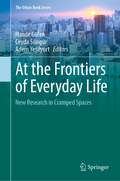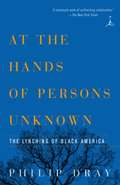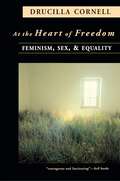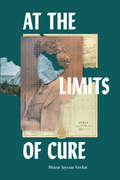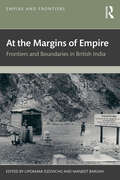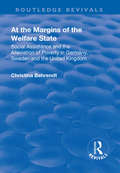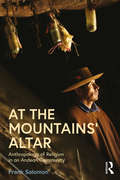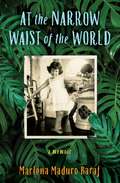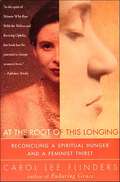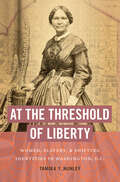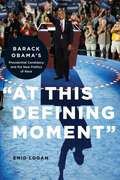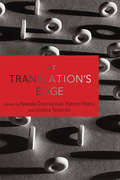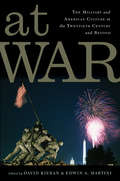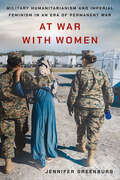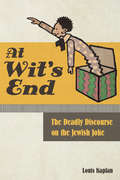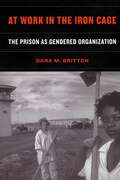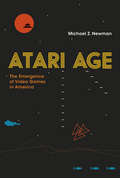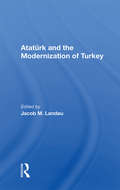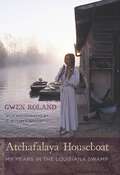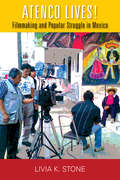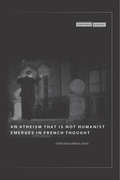- Table View
- List View
At the Frontiers of Everyday Life: New Research in Cramped Spaces (The Urban Book Series)
by Hande Gülen Ceyda Sungur Adem YeşilyurtThe book provides a critical analysis of the geographies of everyday life, looking at how spatial practices craft w(r)iggle room to cope with the boundaries saturated by normativity, power relations, and inequalities. It explores the possibilities for making do with the everyday practices forming a way of living in cramped spaces. In this respect, early-career researchers and activists share their fieldwork experiences through an intersectional lens based on emerging research methodologies and scholar-activist practices. From their own vantage point, they look at their own contexts, practices, and research subjects at the level of everyday life.Spatial practices and place-based imaginaries from France, Finland, and Spain to Turkey and South Africa present a wide range of non-counter hegemonic yet enabling practices for transformation in everyday life. The contributors, trained in a variety of convergent disciplines concerned with everyday life and space (geography, geopolitics, architecture, urban planning, sociology, political sciences), discuss scholar-activist methodologies during the current crisis in contemporary academia, reflect on their research methodologies and research experiences, and inquire into the ways of embodied negotiations for agency, survival, and care.A group of early-career researchers and activists came together to seek out the possibilities of transformative change in everyday life during the peak periods of COVID-19. When researchers and activists were forced to stay at home in isolation, the authors met up online to discuss their subjectivities self-reflexively to challenge the distance between the researcher and “the field.” The book is the outcome of their collective production based on numerous meetings, writing workshops, and creative debates.
At the Hands of Persons Unknown: The Lynching of Black America
by Philip DrayWinner of the Southern Book Critics Circle Award for Nonfiction. This extraordinary account of lynching in America, by acclaimed civil rights historian Philip Dray, shines a clear, bright light on American history's darkest stain--illuminating its causes, perpetrators, apologists, and victims. Philip Dray also tells the story of the men and women who led the long and difficult fight to expose and eradicate lynching, including Ida B. Wells, James Weldon Johnson, Walter White, and W. E. B. Du Bois.
At the Heart of Freedom: Feminism, Sex, and Equality
by Drucilla CornellHow can women create a meaningful and joyous life for themselves? Is it enough to be equal with men? In this provocative and wide-ranging book, Drucilla Cornell argues that women should transcend the quest for equality and focus on what she shows is a far more radical project: achieving freedom. Cornell takes us on a highly original exploration of what it would mean for women politically, legally, and culturally, if we took this ideal of freedom seriously--if, in her words, we recognized that "hearts starve as well as bodies." She takes forceful and sometimes surprising stands on such subjects as abortion, prostitution, pornography, same-sex marriage, international human rights, and the rights and obligations of fathers. She also engages with what it means to be free on a theoretical level, drawing on the ideas of such thinkers as Kant, Rawls, Ronald Dworkin, Hegel, and Lacan. Cornell begins by discussing what she believes lies at the heart of freedom: the ability for all individuals to pursue happiness in their own way, especially in matters of love and sex. This is only possible, she argues, if we protect the "imaginary domain"--a psychic and moral space in which individuals can explore their own sources of happiness. She writes that equality with men does not offer such protection, in part because men themselves are not fully free. Instead, women must focus on ensuring that individuals face minimal interference from the state and from oppressive cultural norms. They must also respect some controversial individual choices. Cornell argues in favor of permitting same-sex couples to marry and adopt children, for example. She presses for access to abortion and for universal day care. She also justifies lifestyles that have not always been supported by other feminists, ranging from staying at home as a primary caregiver to engaging in prostitution. She argues that men should have similar freedoms--thus returning feminism to its promise that freedom for women would mean freedom for all. Challenging, passionate, and powerfully argued, Cornell's book will have a major impact on the course of feminist thought.
At the Limits of Cure (Critical Global Health: Evidence, Efficacy, Ethnography)
by Bharat Jayram VenkatCan a history of cure be more than a history of how disease comes to an end? In 1950s Madras, an international team of researchers demonstrated that antibiotics were effective in treating tuberculosis. But just half a century later, reports out of Mumbai stoked fears about the spread of totally drug-resistant strains of the disease. Had the curable become incurable? Through an anthropological history of tuberculosis treatment in India, Bharat Jayram Venkat examines what it means to be cured, and what it means for a cure to come undone. At the Limits of Cure tells a story that stretches from the colonial period—a time of sanatoria, travel cures, and gold therapy—into a postcolonial present marked by antibiotic miracles and their failures. Venkat juxtaposes the unraveling of cure across a variety of sites: in idyllic hill stations and crowded prisons, aboard ships and on the battlefield, and through research trials and clinical encounters. If cure is frequently taken as an ending (of illness, treatment, and suffering more generally), Venkat provides a foundation for imagining cure otherwise in a world of fading antibiotic efficacy.
At the Limits of Justice
by Sherene Razack Suvendrini PereraThe fear and violence that followed the events of September 11, 2001 touched lives all around the world, even in places that few would immediately associate with the global war on terror. In At the Limits of Justice, twenty-nine contributors from six countries explore the proximity of terror in their own lives and in places ranging from Canada and the United States to Jamaica, Palestine/Israel, Australia, Guyana, Chile, Pakistan, and across the African continent.In this collection, female scholars of colour - including leading theorists on issues of indigeneity, race, and feminism - examine the political, social, and personal repercussions of the war on terror through contributions that range from testimony and poetry to scholarly analysis. Inspired by both the personal and the global impact of this violence within the war on terror, they expose the way in which the war on terror is presented as a distant and foreign issue at the same time that it is deeply present in the lives of women and others all around the world.An impassioned but rigorous examination of issues of race and gender in contemporary politics, At the Limits of Justice is also a call to create moral communities which will find terror and violence unacceptable.
At the Margins of Empire: Frontiers and Boundaries in British India (Empire and Frontiers)
by Lipokmar Dzüvichü and Manjeet BaruahEmpire building in British India was inseparably tied to the processes of frontier-making and the creation of boundaries. Through a range of complex practices and developments, the constitution of these spaces took shape at various historical conjunctures. The making of these spaces was also shaped by a variety of imperial concerns, including local and global processes, connections, and entanglements. Focusing on the period between the 19th and the early 20th centuries, this book looks at how the dynamics of frontier and boundary creation were shaped by a variety of agents, institutions, infrastructure and technologies, events, economy, travel, forms of representation, and imperial rivalries. The role of capital, war, and violence was also intrinsic to the creation of such spaces. Further, societies in these spaces responded to these processes in various ways. The book examines how they negotiated and mediated these complex developments of modern space-making in multiple ways at the margins of empire.Part of the Empire and Frontiers series, this book will be of interest to researchers and readers of history, anthropology, cultural studies, social and cultural history, frontiers, boundaries and borderland studies, Himalayan studies, and studies of commodities and circulations.
At the Margins of the Welfare State: Social Assistance and the Alleviation of Poverty in Germany, Sweden and the United Kingdom (Routledge Revivals)
by Christina BehrendtThe persistence of poverty in advanced welfare states casts doubt on the fundamental operating procedures of income distribution and redistribution. What are the reasons for this apparent failure of the welfare state in alleviating poverty? Why are some countries more effective than others in this respect and what can explain these variations in effectiveness? Addressing one of the major puzzles in comparative welfare state research, this volume examines why there is income poverty in highly developed welfare states. Focusing on the basic safety net of the welfare state, it offers a systematic analysis of the effectiveness of minimum income schemes in a comparative study across three highly developed welfare states: Germany, Sweden and the United Kingdom. Blending insights from a combination of institutional information and quantitative data from income surveys, the author evaluates the causal mechanisms for the persistence of income poverty in highly developed welfare states and derives conclusions for political reforms
At the Mountains’ Altar: Anthropology of Religion in an Andean Community
by Frank SalomonIn high-Andean Peru, Rapaz village maintains a temple to mountain beings who command water and weather. By examining the ritual practices and belief systems of an Andean community, this book provides students with rich understandings of unfamiliar religious experiences and delivers theories of religion from the realm of abstraction. From core field encounters, each chapter guides readers outward in a different theoretical direction, successively exploring the main paths in the anthropology of religion. As well as addressing classical approaches in the anthropology of religion to rural modernity, Salomon engages with newer currents such as cognitive-evolution models, power-oriented critiques, the ontological reworking of relativism, and the "new materialism" in the context of a deep-rooted Andean ethos. He reflects on central questions such as: Why does sacred ritualism seem almost universal? Is it seated in social power, human psychology, symbolic meanings, or cultural logics? Are varied theories compatible? Is "religion" still a tenable category in the post-colonial world? At the Mountains’ Altar is a valuable resource for students taking courses on the anthropology of religion, Andean cultures, Latin American ethnography, religious studies, and indigenous peoples of the Americas.
At the Narrow Waist of the World: A Memoir
by Marlena Maduro Baraf&“With sensitivity and candor, Baraf examines mental illness, immigration, forgiveness, and community—all framed within the precocity of her life&’s circumstances.&” —Ms. Magazine &“At the Narrow Waist of the World is a compelling account of what it is like to live through turbulence and come out on the other side.&” —Foreword Clarion Review &“Deftly written, impressively candid, insightfully presented, At the Narrow Waist of the World is an extraordinary and memorable read.&” —Midwest Book Review &“By the end of At the Narrow Waist of the World, we have come to know, admire and even cherish its author in a way few memoirists manage to achieve . . . . &” —Jewish Journal Raised by a lively family of Spanish Jews in tropical and Catholic Panama of the 1950s and 1960s, Marlena depends on her many tíos and tías for refuge from the difficulties of life, including the frequent absences of her troubled mother. As a teenager, she pulls away from this centered world—crossing borders—and begins a life in the United States very different from the one she has known. This lyrical coming-of-age memoir explores the intense and profound relationship between mothers and daughters and highlights the importance of community and the beauty of a large Latin American family. It also explores the vital issues of mental illness and healing, forgiveness and acceptance. At the Narrow Waist of the World examines the author's gradual integration into a new culture, even as she understands that her home is still—and always will be—rooted in another place.
At the Root of This Longing: Reconciling a Spiritual Hunger and a Feminist Thirst
by Carol L. FlindersIn At the Root of This Longing, Flinders identifies the four key points at which the paths of spirituality and feminism seem to collide—vowing silence vs. finding voice, relinquishing ego vs. establishing 'self', resisting desire vs. reclaiming the body, and enclosure vs. freedom—and sets out to discover not only the sources of these conflicts, but how they can be reconciled. With a sense of urgency brought on by events in her own life, Flinders deals with the alienation that women have experienced not only from themselves and each other, but from the sacred. She finds inspiration in the story of fourteenth-century mystic Julian of Norwich and her direct experience of God, in India's legendary Draupadi, who would not allow a brutal physical assault to damage her sense of personal power, as well as in Flinders's own experiences as a meditation teacher and practitioner. Flinders reveals that spirituality and feminism are not mutually exclusive at all but very much require one another.
At the Threshold of Liberty: Women, Slavery, and Shifting Identities in Washington, D.C. (The John Hope Franklin Series in African American History and Culture)
by Tamika Y. NunleyThe capital city of a nation founded on the premise of liberty, nineteenth-century Washington, D.C., was both an entrepot of urban slavery and the target of abolitionist ferment. The growing slave trade and the enactment of Black codes placed the city's Black women within the rigid confines of a social hierarchy ordered by race and gender. At the Threshold of Liberty reveals how these women--enslaved, fugitive, and free--imagined new identities and lives beyond the oppressive restrictions intended to prevent them from ever experiencing liberty, self-respect, and power.Consulting newspapers, government documents, letters, abolitionist records, legislation, and memoirs, Tamika Y. Nunley traces how Black women navigated social and legal proscriptions to develop their own ideas about liberty as they escaped from slavery, initiated freedom suits, created entrepreneurial economies, pursued education, and participated in political work. In telling these stories, Nunley places Black women at the vanguard of the history of Washington, D.C., and the momentous transformations of nineteenth-century America.
“At This Defining Moment”: Barack Obama’s Presidential Candidacy and the New Politics of Race
by Enid Lynette LoganIn January 2009, Barack Obama became the 44th president of the United States. In the weeks and months following the election, as in those that preceded it, countless social observers from across the ideological spectrum commented upon the cultural, social and political significance of “the Obama phenomenon.” In “At this Defining Moment,” Enid Logan provides a nuanced analysis framed by innovative theoretical insights to explore how Barack Obama’s presidential candidacy both reflected and shaped the dynamics of race in the contemporary United States. Using the 2008 election as a case study of U.S. race relations, and based on a wealth of empirical data that includes an analysis of over 1,500 newspaper articles, blog postings, and other forms of public speech collected over a 3 year period, Logan claims that while race played a central role in the 2008 election, it was in several respects different from the past. Logan ultimately concludes that while the selection of an individual African American man as president does not mean that racism is dead in the contemporary United States, we must also think creatively and expansively about what the election does mean for the nation and for the evolving contours of race in the 21st century.
At Translation's Edge (Media Matters)
by Lydia H Liu John Cayley Russell Scott Valentino Naoki Sakai Deborah Folaron Margaret A Noodin Yiman Wang Martha Pulido Olga Behar Elizabeth R Drame Suzanne Jill Levine Lorena TerandoSince the 1970s, the field of Translation Studies has entered into dialogue with an array of other disciplines, sustaining a close but contentious relationship with literary translation. At Translation’s Edge expands this interdisciplinary dialogue by taking up questions of translation across sub-fields and within disciplines, including film and media studies, comparative literature, history, and education among others. For the contributors to this volume, translation is understood in its most expansive, transdisciplinary sense: translation as exchange, migration, and mobility, including cross-cultural communication and media circulation. Whether exploring the Universal Declaration of Human Rights or silent film intertitles, this volume brings together the work of scholars aiming to address the edges of Translation Studies while engaging with major and minor languages, colonial and post-colonial studies, feminism and disability studies, and theories of globalization and empire.
At War: The Military and American Culture in the Twentieth Century and Beyond (War Culture)
by David Kieran Edwin A. Martini Sahr Conway-Lanz Stefan Aune Nick Witham Mark R. Wilson Jennifer Mittelstadt Christopher Hamner Wilbur J. Scott Jana K. Lipman Christine Knauer Kara Dixon Vuic John M. Kinder Richard P. Tucker Susan L. Carruthers Bonnie M. Miller Scott Laderman Professor G. Kurt Piehler Katherine Ellison William WatsonThe country’s wars in Iraq and Afghanistan, its interventions around the world, and its global military presence make war, the military, and militarism defining features of contemporary American life. The armed services and the wars they fight shape all aspects of life—from the formation of racial and gendered identities to debates over environmental and immigration policy. Warfare and the military are ubiquitous in popular culture. At War offers short, accessible essays addressing the central issues in the new military history—ranging from diplomacy and the history of imperialism to the environmental issues that war raises and the ways that war shapes and is shaped by discourses of identity, to questions of who serves in the U.S. military and why and how U.S. wars have been represented in the media and in popular culture.
At War With Ourselves: Why America Is Squandering Its Chance to Build a Better World
by Michael HirshForeign policy analysis.
At War with Women: Military Humanitarianism and Imperial Feminism in an Era of Permanent War
by Jennifer GreenburgAt War with Women reveals how post-9/11 politics of gender and development have transformed US military power. In the mid-2000s, the US military used development as a weapon as it revived counterinsurgency in Iraq and Afghanistan. The military assembled all-female teams to reach households and wage war through development projects in the battle for "hearts and minds." Despite women technically being banned from ground combat units, the all-female teams were drawn into combat nonetheless. Based on ethnographic fieldwork observing military trainings, this book challenges liberal feminist narratives that justified the Afghanistan War in the name of women's rights and celebrated women's integration into combat as a victory for gender equality. Jennifer Greenburg critically interrogates a new imperial feminism and its central role in securing US hegemony. Women's incorporation into combat through emotional labor has reinforced gender stereotypes, with counterinsurgency framing female soldiers as global ambassadors for women's rights. This book provides an analysis of US imperialism that keeps the present in tension with the past, clarifying where colonial ideologies of race, gender, and sexuality have resurfaced and how they are changing today.
At Wit's End: The Deadly Discourse on the Jewish Joke
by Louis KaplanCHOICE: OUTSTANDING ACADEMIC TITLEA scholarly and thought-provoking work that places Jewish humor at the center of a discourse about Jewish and German relations through most of the twentieth century.At Wit’s End explores the fascinating discourse on Jewish wit in the twentieth century when the Jewish joke became the subject of serious humanistic inquiry and inserted itself into the cultural and political debates among Germans and Jews against the ideologically charged backdrop of anti-Semitism, the Jewish question, and the Holocaust.The first in-depth study to explore the Jewish joke as a crucial rhetorical figure in larger cultural debates in Germany, author Louis Kaplan presents an engrossing and lucid work of scholarship that examines how “der jüdische Witz” (referring to both Jewish wit and jokes) was utilized differently in a number of texts, from the Weimar Republic to the rise of National Socialism, and how it was re-introduced into the public sphere after the Holocaust with the controversial publication of Salcia Landmann’s collection of Jewish jokes in the reparations era (Wiedergutmachung). Kaplan reviews the claims made about the Jewish joke and its provocative laughter by notable writers from a variety of ideological perspectives, demonstrating how their reflections on this complex cultural trope enable a better understanding of German–Jewish intercultural relations and their eventual breakdown in the Third Reich. He also illustrates how selfcritical and self-ironic Jewish Witz maintained a fraught and ambivalent relationship with anti-Semitism.In reviewing this critical and traumatic moment in modern German–Jewish history through the deadly discourse on the Jewish joke, At Wit’s End includes chapters on the virulent Austrian anti-Semitic racial theorist Arthur Trebitsch, the Nazi racial propagandist Siegfried Kadner, the German Marxist cultural historian Eduard Fuchs, the Jewish diasporic historian Erich Kahler, and the Jewish cabaret impresario Kurt Robitschek, among others. Shedding new light on anti-Semitism and on the Jewish question leading up to the Holocaust, At Wit’s End provides readers with a unique perspective by which to gain important insights about this crucial historical period that reverberates into the present day, when potentially offensive humor coupled with a toxic political climate and xenophobia can have deadly consequences.
At Work in the Iron Cage: The Prison as Gendered Organization
by Dana M. BrittonWhen most people think of prisons, they imagine chaos, violence, and fundamentally, an atmosphere of overwhelming brute masculinity. But real prisons rarely fit the “Big House” stereotype of popular film and literature. One fifth of all correctional officers are women, and the rate at which women are imprisoned is growing faster than that of men. Yet, despite increasing numbers of women prisoners and officers, ideas about prison life and prison work are sill dominated by an exaggerated image of men’s prisons where inmates supposedly struggle for physical dominance.In a rare comparative analysis of men’s and women’s prisons, Dana Britton identifies the factors that influence the gendering of the American workplace, a process that often leaves women in lower-paying jobs with less prestige and responsibility.In interviews with dozens of male and female officers in five prisons, Britton explains how gender shapes their day-to-day work experiences. Combining criminology, penology, and feminist theory, she offers a radical new argument for the persistence of gender inequality in prisons and other organizations. At Work in the Iron Cage demonstrates the importance of the prison as a site of gender relations as well as social control.
Atari Age: The Emergence of Video Games in America
by Michael Z. NewmanThe cultural contradictions of early video games: a medium for family fun (but mainly for middle-class boys), an improvement over pinball and television (but possibly harmful) Beginning with the release of the Magnavox Odyssey and Pong in 1972, video games, whether played in arcades and taverns or in family rec rooms, became part of popular culture, like television. In fact, video games were sometimes seen as an improvement on television because they spurred participation rather than passivity. These “space-age pinball machines” gave coin-operated games a high-tech and more respectable profile. In Atari Age, Michael Newman charts the emergence of video games in America from ball-and-paddle games to hits like Space Invaders and Pac-Man, describing their relationship to other amusements and technologies and showing how they came to be identified with the middle class, youth, and masculinity.Newman shows that the “new media” of video games were understood in varied, even contradictory ways. They were family fun (but mainly for boys), better than television (but possibly harmful), and educational (but a waste of computer time). Drawing on a range of sources—including the games and their packaging; coverage in the popular, trade, and fan press; social science research of the time; advertising and store catalogs; and representations in movies and television—Newman describes the series of cultural contradictions through which the identity of the emerging medium worked itself out. Would video games embody middle-class respectability or suffer from the arcade's unsavory reputation? Would they foster family togetherness or allow boys to escape from domesticity? Would they make the new home computer a tool for education or just a glorified toy? Then, as now, many worried about the impact of video games on players, while others celebrated video games for familiarizing kids with technology essential for the information age.
Ataturk And The Modernization Of Turkey
by Jacob M LandauMustafa Kemal Atatürk, who founded the Republic of Turkey sixty years ago, dedicated himself to westernizing the Turkish state and its society and culture. In this first attempt to evaluate Ataturk's overall contribution to the modernization of Turkey, an international group of scholars examine a broad range of subjects, including the Kemalist
Atchafalaya Houseboat: My Years in the Louisiana Swamp
by Gwen RolandIn the early 1970s, two idealistic young people—Gwen Carpenter Roland and Calvin Voisin—decided to leave civilization and re-create the vanished simple life of their great-grandparents in the heart of Louisiana's million-acre Atchafalaya River Basin Swamp. Armed with a box of crayons and a book called How to Build Your Home in the Woods, they drew up plans to recycle a slave-built structure into a houseboat. Without power tools or building experience they constructed a floating dwelling complete with a brick fireplace. Towed deep into the sleepy waters of Bloody Bayou, it was their home for eight years. This is the tale of the not-so-simple life they made together—days spent fishing, trading, making wine, growing food, and growing up—told by Gwen with grace, economy, and eloquence.Not long after they took up swamp living, Gwen and Calvin met a young photographer named C. C. Lockwood, who shared their "back to the earth" values. His photographs of the couple going about their daily routine were published in National Geographic magazine, bringing them unexpected fame. More than a quarter of a century later, after Gwen and Calvin had long since parted, one of Lockwood's photos of them appeared in a National Geographic collector's edition entitled 100 Best Pictures Unpublished—and kindled the interest of a new generation.With quiet wisdom, Gwen recounts her eight-year voyage of discovery—about swamp life, wildlife, and herself. A keen observer of both the natural world and the ways of human beings, she transports readers to an unfamiliar and exotic place.
Atenco Lives!: Filmmaking and Popular Struggle in Mexico (Performing Latin American and Caribbean Identities)
by Livia K. StoneThe People's Front in Defense of Land of Atenco (the "Frente") is an emblematic force in contemporary Mexican politics and in anti-capitalist, anti-neoliberal activist networks throughout the world. Best known for years of resistance against the encroachment of a government airport project on communal farmland, the Frente also became international news when its members were subject to state violence, rape, and intimidation in a brutal government crackdown in 2006. Through it all, documentary filmmaking has been one aspect of the Frente and its allies' efforts. The contradictions and difficulties of this moral and political project emerge in the day-to-day experiences of local, national, and international filmmakers and film distributors seeking to participate in the social movement.Stone highlights the importance of how the circulation of the physical videos, and not just their content, promotes the social movement. More broadly she shows how videographers perform their activism, navigating the tensions between neoliberal personhood or ego and an ethos of compañerismo that privileges community. Grounded in the lived experiences of Atenco's activists and allied filmmakers, Atenco Lives! documents the making and circulating of films as an ethical and political practice purposefully used to transform human relationships.
Atenco Lives!: Filmmaking and Popular Struggle in Mexico (Performing Latin American and Caribbean Identities)
by Livia K. StoneThe People's Front in Defense of Land of Atenco (the "Frente") is an emblematic force in contemporary Mexican politics and in anti-capitalist, anti-neoliberal activist networks throughout the world. Best known for years of resistance against the encroachment of a government airport project on communal farmland, the Frente also became international news when its members were subject to state violence, rape, and intimidation in a brutal government crackdown in 2006. Through it all, documentary filmmaking has been one aspect of the Frente and its allies' efforts. The contradictions and difficulties of this moral and political project emerge in the day-to-day experiences of local, national, and international filmmakers and film distributors seeking to participate in the social movement. Stone highlights the importance of how the circulation of the physical videos, and not just their content, promotes the social movement. More broadly she shows how videographers perform their activism, navigating the tensions between neoliberal personhood or ego and an ethos of compañerismo that privileges community. Grounded in the lived experiences of Atenco's activists and allied filmmakers, Atenco Lives! documents the making and circulating of films as an ethical and political practice purposefully used to transform human relationships.
Atheism and the Goddess: Cross-Cultural Approaches with a Focus on South Asia
by Anway MukhopadhyayThis book seeks to explore the complex modes of interface between religion, atheism, and the Goddess in multicultural contexts. While atheism has often been seen as an interrogation of and a battle against God, the gender dimension of this discourse has not been sufficiently negotiated. Is the fight against God also a fight against the Goddess? Or is there something common between the ideological thrust of the battle against God the “Father” in atheism and the interrogation of the Divine Father in thealogy? Can the Goddess be seen as an entity radically different from the imperious transcendental that the atheists find embodied in God the Father? Or, can the Goddess be seen as “transcendental” as well as immanent, and hence subjected to the same atheist denial of transcendence to which God is subjected in non-theistic or anti-theistic arguments? With this volume, Anway Mukhopadhyay embarks on a difficult project of epistemologically, ideologically and even politically renegotiating and reorienting some of the fundamental issues involved in the discussions of and debates over atheism.
An Atheism That Is Not Humanist Emerges in French Thought
by Stefanos GeroulanosIf the 19th century was marked by a "Death of God," than the 20th century evolution of French philosophical and political thought can be said to be marked by the "Death of Man," in that humanism (placing the human at the center of understandings of knowledge, thought, and ethics) came to be seen by many as inextricably tied to some of the worst disasters of the modern era. Geroulanos (modern European intellectual history, New York U. ) reconstructs the development of this intellectual trend in France during the second quarter of the 20th century, arguing that it should be understood in terms of a synthesis of the interconnected movements of the development of an anti-humanist atheism, the emergence of a negative philosophical anthropology, and the elaboration of critiques of humanism. Annotation ©2010 Book News, Inc. , Portland, OR (booknews. com)
